check oil SATURN ION 2007 User Guide
[x] Cancel search | Manufacturer: SATURN, Model Year: 2007, Model line: ION, Model: SATURN ION 2007Pages: 440, PDF Size: 2.93 MB
Page 274 of 440
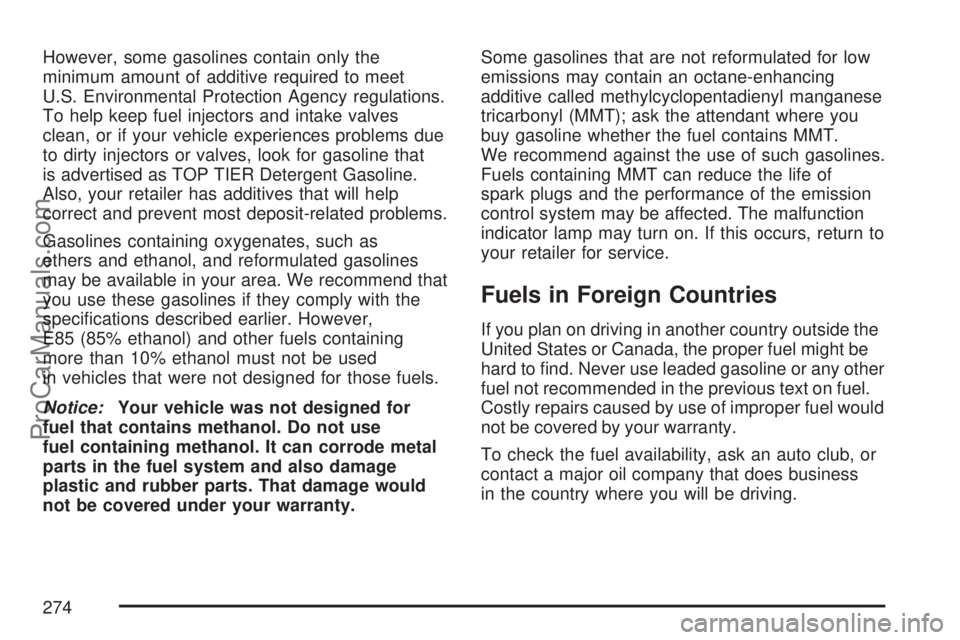
However, some gasolines contain only the
minimum amount of additive required to meet
U.S. Environmental Protection Agency regulations.
To help keep fuel injectors and intake valves
clean, or if your vehicle experiences problems due
to dirty injectors or valves, look for gasoline that
is advertised as TOP TIER Detergent Gasoline.
Also, your retailer has additives that will help
correct and prevent most deposit-related problems.
Gasolines containing oxygenates, such as
ethers and ethanol, and reformulated gasolines
may be available in your area. We recommend that
you use these gasolines if they comply with the
speci�cations described earlier. However,
E85 (85% ethanol) and other fuels containing
more than 10% ethanol must not be used
in vehicles that were not designed for those fuels.
Notice:Your vehicle was not designed for
fuel that contains methanol. Do not use
fuel containing methanol. It can corrode metal
parts in the fuel system and also damage
plastic and rubber parts. That damage would
not be covered under your warranty.Some gasolines that are not reformulated for low
emissions may contain an octane-enhancing
additive called methylcyclopentadienyl manganese
tricarbonyl (MMT); ask the attendant where you
buy gasoline whether the fuel contains MMT.
We recommend against the use of such gasolines.
Fuels containing MMT can reduce the life of
spark plugs and the performance of the emission
control system may be affected. The malfunction
indicator lamp may turn on. If this occurs, return to
your retailer for service.
Fuels in Foreign Countries
If you plan on driving in another country outside the
United States or Canada, the proper fuel might be
hard to �nd. Never use leaded gasoline or any other
fuel not recommended in the previous text on fuel.
Costly repairs caused by use of improper fuel would
not be covered by your warranty.
To check the fuel availability, ask an auto club, or
contact a major oil company that does business
in the country where you will be driving.
274
ProCarManuals.com
Page 278 of 440
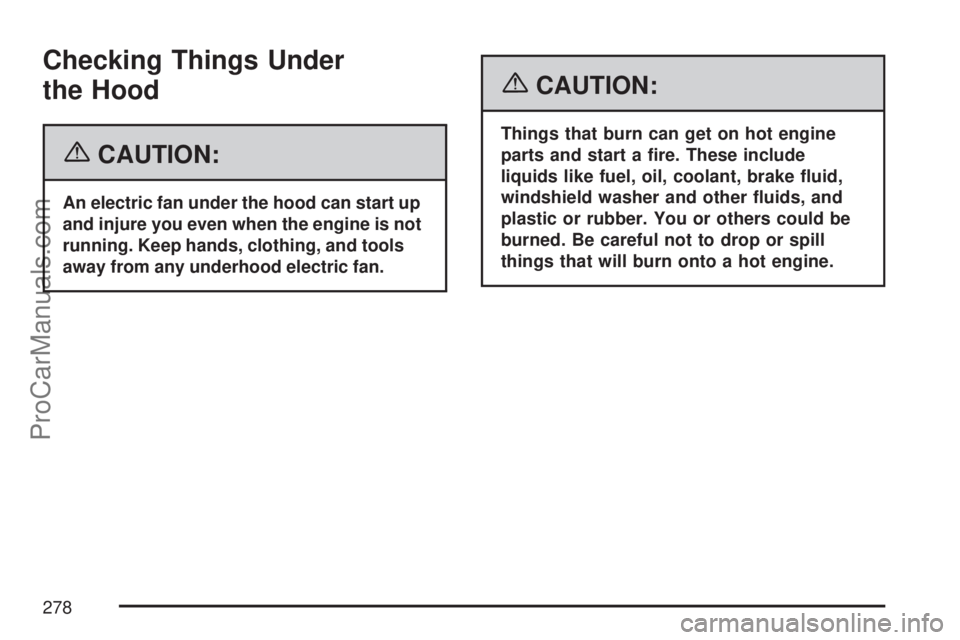
Checking Things Under
the Hood
{CAUTION:
An electric fan under the hood can start up
and injure you even when the engine is not
running. Keep hands, clothing, and tools
away from any underhood electric fan.
{CAUTION:
Things that burn can get on hot engine
parts and start a �re. These include
liquids like fuel, oil, coolant, brake �uid,
windshield washer and other �uids, and
plastic or rubber. You or others could be
burned. Be careful not to drop or spill
things that will burn onto a hot engine.
278
ProCarManuals.com
Page 281 of 440
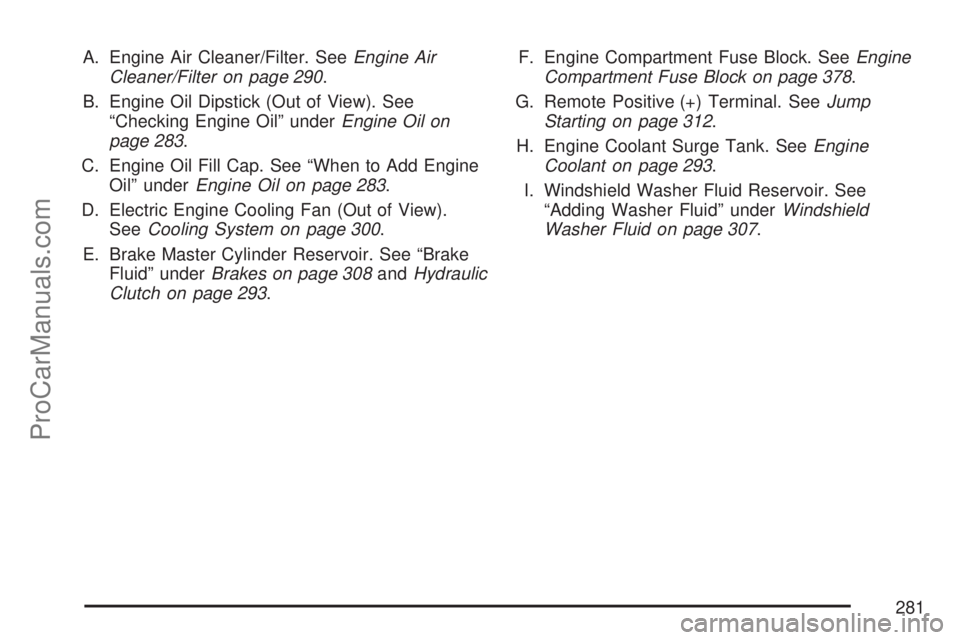
A. Engine Air Cleaner/Filter. SeeEngine Air
Cleaner/Filter on page 290.
B. Engine Oil Dipstick (Out of View). See
“Checking Engine Oil” underEngine Oil on
page 283.
C. Engine Oil Fill Cap. See “When to Add Engine
Oil” underEngine Oil on page 283.
D. Electric Engine Cooling Fan (Out of View).
SeeCooling System on page 300.
E. Brake Master Cylinder Reservoir. See “Brake
Fluid” underBrakes on page 308andHydraulic
Clutch on page 293.F. Engine Compartment Fuse Block. SeeEngine
Compartment Fuse Block on page 378.
G. Remote Positive (+) Terminal. SeeJump
Starting on page 312.
H. Engine Coolant Surge Tank. SeeEngine
Coolant on page 293.
I. Windshield Washer Fluid Reservoir. See
“Adding Washer Fluid” underWindshield
Washer Fluid on page 307.
281
ProCarManuals.com
Page 283 of 440
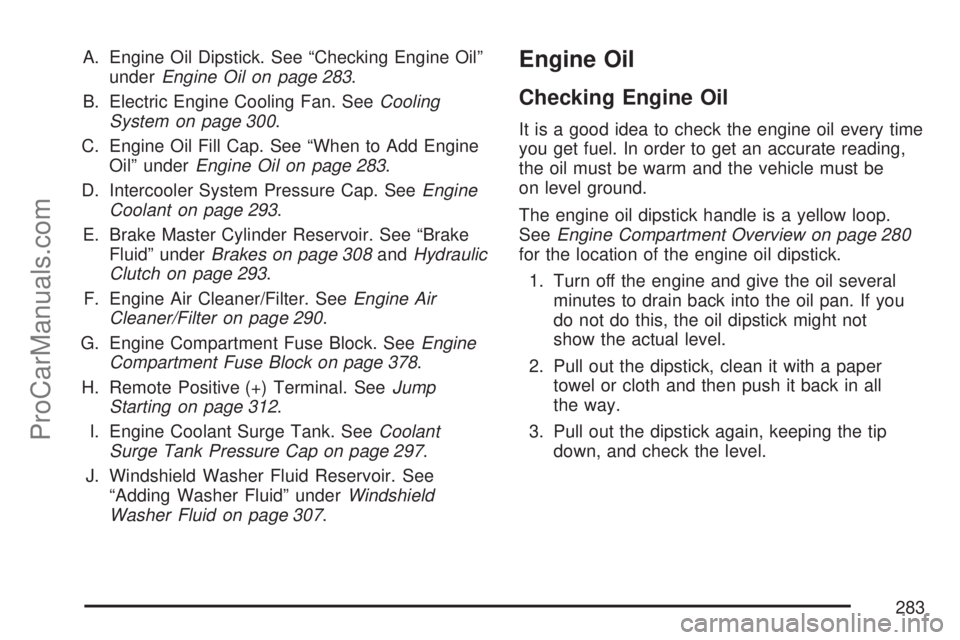
A. Engine Oil Dipstick. See “Checking Engine Oil”
underEngine Oil on page 283.
B. Electric Engine Cooling Fan. SeeCooling
System on page 300.
C. Engine Oil Fill Cap. See “When to Add Engine
Oil” underEngine Oil on page 283.
D. Intercooler System Pressure Cap. SeeEngine
Coolant on page 293.
E. Brake Master Cylinder Reservoir. See “Brake
Fluid” underBrakes on page 308andHydraulic
Clutch on page 293.
F. Engine Air Cleaner/Filter. SeeEngine Air
Cleaner/Filter on page 290.
G. Engine Compartment Fuse Block. SeeEngine
Compartment Fuse Block on page 378.
H. Remote Positive (+) Terminal. SeeJump
Starting on page 312.
I. Engine Coolant Surge Tank. SeeCoolant
Surge Tank Pressure Cap on page 297.
J. Windshield Washer Fluid Reservoir. See
“Adding Washer Fluid” underWindshield
Washer Fluid on page 307.Engine Oil
Checking Engine Oil
It is a good idea to check the engine oil every time
you get fuel. In order to get an accurate reading,
the oil must be warm and the vehicle must be
on level ground.
The engine oil dipstick handle is a yellow loop.
SeeEngine Compartment Overview on page 280
for the location of the engine oil dipstick.
1. Turn off the engine and give the oil several
minutes to drain back into the oil pan. If you
do not do this, the oil dipstick might not
show the actual level.
2. Pull out the dipstick, clean it with a paper
towel or cloth and then push it back in all
the way.
3. Pull out the dipstick again, keeping the tip
down, and check the level.
283
ProCarManuals.com
Page 288 of 440
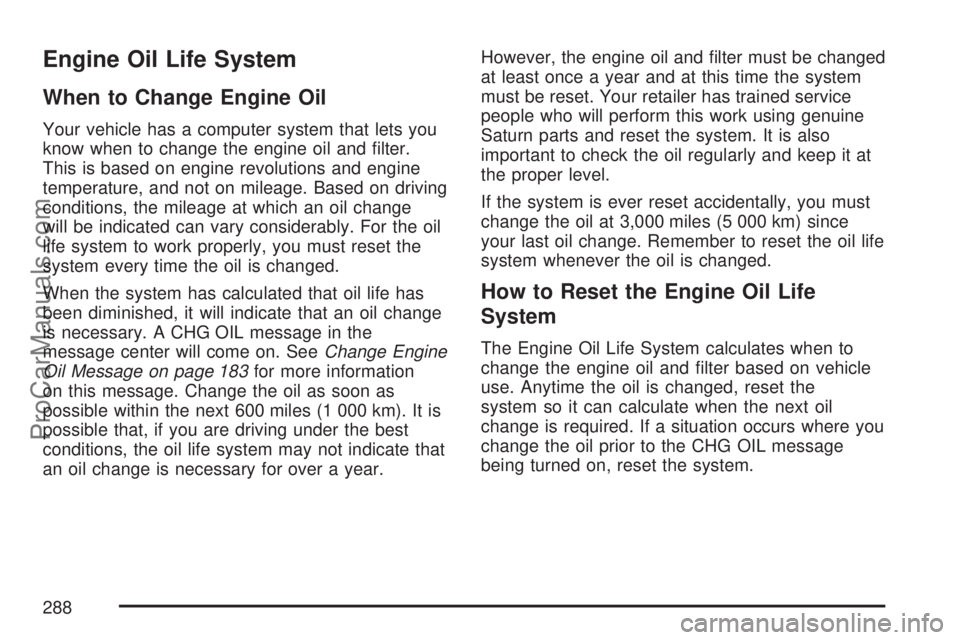
Engine Oil Life System
When to Change Engine Oil
Your vehicle has a computer system that lets you
know when to change the engine oil and �lter.
This is based on engine revolutions and engine
temperature, and not on mileage. Based on driving
conditions, the mileage at which an oil change
will be indicated can vary considerably. For the oil
life system to work properly, you must reset the
system every time the oil is changed.
When the system has calculated that oil life has
been diminished, it will indicate that an oil change
is necessary. A CHG OIL message in the
message center will come on. SeeChange Engine
Oil Message on page 183for more information
on this message. Change the oil as soon as
possible within the next 600 miles (1 000 km). It is
possible that, if you are driving under the best
conditions, the oil life system may not indicate that
an oil change is necessary for over a year.However, the engine oil and �lter must be changed
at least once a year and at this time the system
must be reset. Your retailer has trained service
people who will perform this work using genuine
Saturn parts and reset the system. It is also
important to check the oil regularly and keep it at
the proper level.
If the system is ever reset accidentally, you must
change the oil at 3,000 miles (5 000 km) since
your last oil change. Remember to reset the oil life
system whenever the oil is changed.
How to Reset the Engine Oil Life
System
The Engine Oil Life System calculates when to
change the engine oil and �lter based on vehicle
use. Anytime the oil is changed, reset the
system so it can calculate when the next oil
change is required. If a situation occurs where you
change the oil prior to the CHG OIL message
being turned on, reset the system.
288
ProCarManuals.com
Page 293 of 440

Manual Transaxle Fluid
It is not necessary to check the transaxle �uid level.
A transaxle �uid leak is the only reason for �uid
loss. If a leak occurs, take the vehicle to your
retailer’s service department and have it repaired
as soon as possible. SeeRecommended Fluids
and Lubricants on page 402for the proper �uid
to use.
Hydraulic Clutch
The hydraulic clutch linkage in your vehicle is
self-adjusting. This system does not have its own
reservoir. It receives �uid from the brake master
cylinder reservoir.
SeeBrakes on page 308for more information.
Engine Coolant
The cooling system in your vehicle is �lled with
DEX-COOL®engine coolant. This coolant is
designed to remain in your vehicle for �ve years or
150,000 miles (240 000 km), whichever occurs
�rst, if you add only DEX-COOL
®extended
life coolant.The following explains your cooling system and
how to add coolant when it is low. If you have
a problem with engine overheating, seeEngine
Overheating on page 297.
A 50/50 mixture of clean, drinkable water and
DEX-COOL
®coolant will:
Give freezing protection down to
−34°F (−37°C).
Give boiling protection up to 265°F (129°C).
Protect against rust and corrosion.
Help keep the proper engine temperature.
Let the warning lights and gages work as
they should.
Notice:Using coolant other than DEX-COOL
®
may cause premature engine, heater core, or
radiator corrosion. In addition, the engine
coolant may require changing sooner, at the
�rst maintenance service after each
30,000 miles (50 000 km) or 24 months,
whichever occurs �rst. Any repairs would not
be covered by your warranty. Always use
DEX-COOL
®(silicate-free) coolant in your
vehicle.
293
ProCarManuals.com
Page 294 of 440
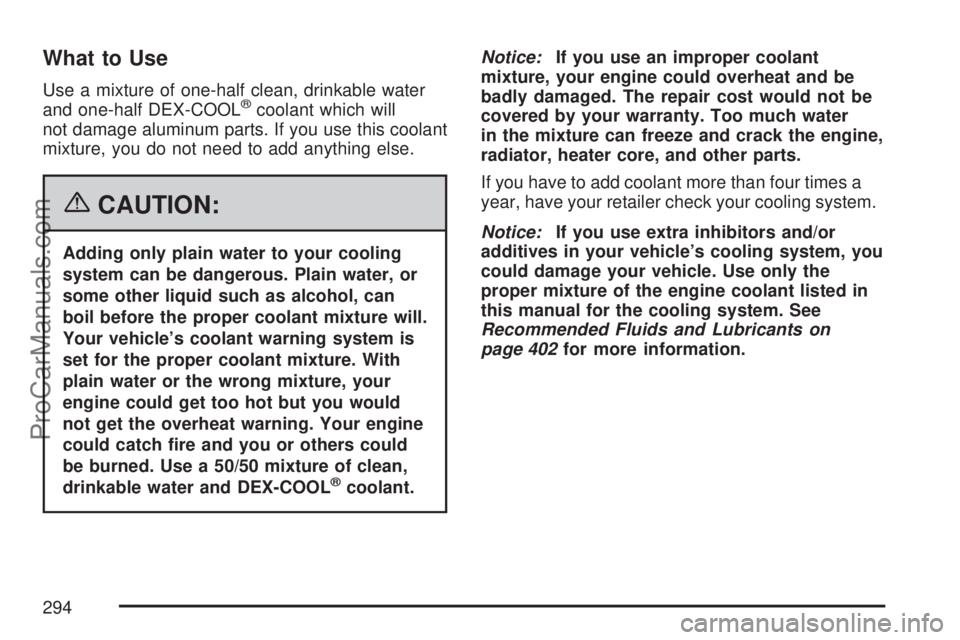
What to Use
Use a mixture of one-half clean, drinkable water
and one-half DEX-COOL®coolant which will
not damage aluminum parts. If you use this coolant
mixture, you do not need to add anything else.
{CAUTION:
Adding only plain water to your cooling
system can be dangerous. Plain water, or
some other liquid such as alcohol, can
boil before the proper coolant mixture will.
Your vehicle’s coolant warning system is
set for the proper coolant mixture. With
plain water or the wrong mixture, your
engine could get too hot but you would
not get the overheat warning. Your engine
could catch �re and you or others could
be burned. Use a 50/50 mixture of clean,
drinkable water and DEX-COOL
®coolant.Notice:If you use an improper coolant
mixture, your engine could overheat and be
badly damaged. The repair cost would not be
covered by your warranty. Too much water
in the mixture can freeze and crack the engine,
radiator, heater core, and other parts.
If you have to add coolant more than four times a
year, have your retailer check your cooling system.
Notice:If you use extra inhibitors and/or
additives in your vehicle’s cooling system, you
could damage your vehicle. Use only the
proper mixture of the engine coolant listed in
this manual for the cooling system. See
Recommended Fluids and Lubricants on
page 402for more information.
294
ProCarManuals.com
Page 302 of 440

How to Add Coolant to the Coolant
Surge Tank
If you have not found a problem yet, check to see
if coolant is visible in the surge tank. If coolant
is visible but the coolant level is not at the cold �ll
line, add a 50/50 mixture of clean, drinkable
water and DEX-COOL
®coolant at the coolant
surge tank, but be sure the cooling system,
including the coolant surge tank pressure cap, is
cool before you do it. SeeEngine Coolant on
page 293for more information.
{CAUTION:
Steam and scalding liquids from a hot
cooling system can blow out and burn
you badly. They are under pressure, and if
you turn the coolant surge tank pressure
cap — even a little — they can come out at
high speed. Never turn the cap when the
cooling system, including the coolant
CAUTION: (Continued)
CAUTION: (Continued)
surge tank pressure cap, is hot. Wait for
the cooling system and coolant surge
tank pressure cap to cool if you ever have
to turn the pressure cap.
{CAUTION:
Adding only plain water to your cooling
system can be dangerous. Plain water, or
some other liquid such as alcohol, can
boil before the proper coolant mixture will.
Your vehicle’s coolant warning system is
set for the proper coolant mixture. With
plain water or the wrong mixture, your
engine could get too hot but you would
not get the overheat warning. Your engine
could catch �re and you or others could
be burned. Use a 50/50 mixture of clean,
drinkable water and DEX-COOL
®coolant.
302
ProCarManuals.com
Page 305 of 440
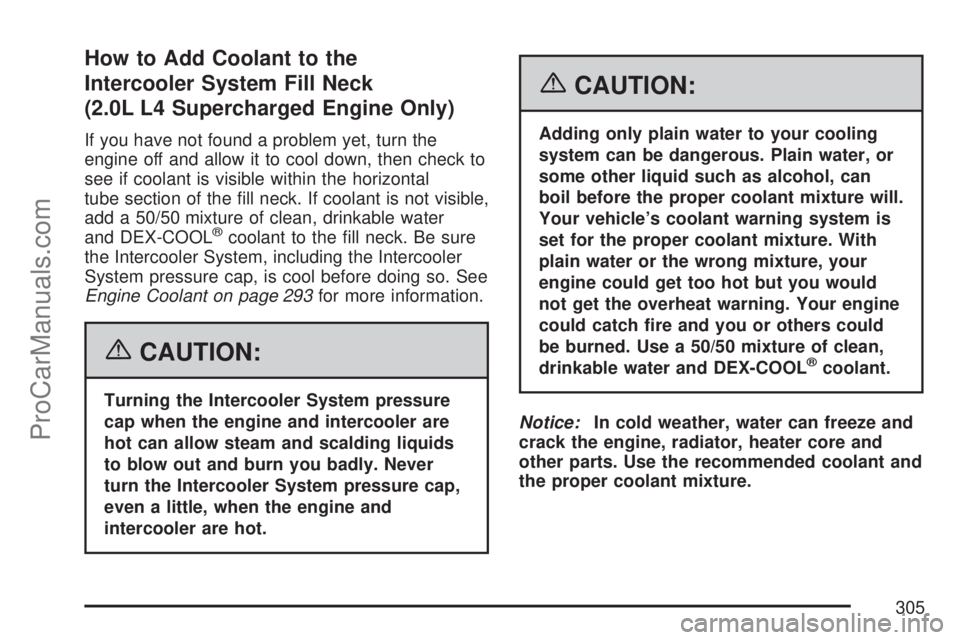
How to Add Coolant to the
Intercooler System Fill Neck
(2.0L L4 Supercharged Engine Only)
If you have not found a problem yet, turn the
engine off and allow it to cool down, then check to
see if coolant is visible within the horizontal
tube section of the �ll neck. If coolant is not visible,
add a 50/50 mixture of clean, drinkable water
and DEX-COOL
®coolant to the �ll neck. Be sure
the Intercooler System, including the Intercooler
System pressure cap, is cool before doing so. See
Engine Coolant on page 293for more information.
{CAUTION:
Turning the Intercooler System pressure
cap when the engine and intercooler are
hot can allow steam and scalding liquids
to blow out and burn you badly. Never
turn the Intercooler System pressure cap,
even a little, when the engine and
intercooler are hot.
{CAUTION:
Adding only plain water to your cooling
system can be dangerous. Plain water, or
some other liquid such as alcohol, can
boil before the proper coolant mixture will.
Your vehicle’s coolant warning system is
set for the proper coolant mixture. With
plain water or the wrong mixture, your
engine could get too hot but you would
not get the overheat warning. Your engine
could catch �re and you or others could
be burned. Use a 50/50 mixture of clean,
drinkable water and DEX-COOL
®coolant.
Notice:In cold weather, water can freeze and
crack the engine, radiator, heater core and
other parts. Use the recommended coolant and
the proper coolant mixture.
305
ProCarManuals.com
Page 309 of 440
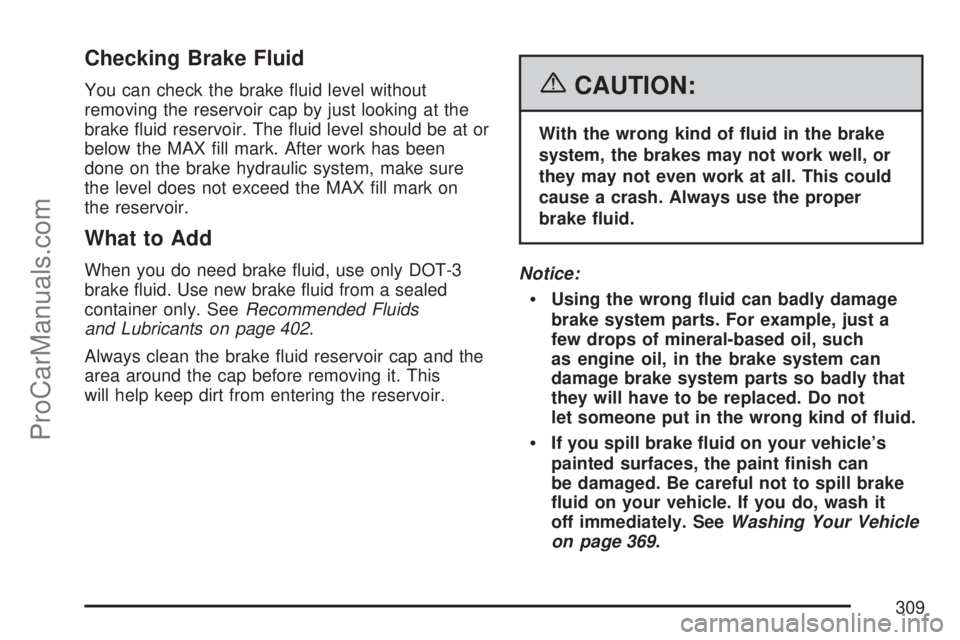
Checking Brake Fluid
You can check the brake �uid level without
removing the reservoir cap by just looking at the
brake �uid reservoir. The �uid level should be at or
below the MAX �ll mark. After work has been
done on the brake hydraulic system, make sure
the level does not exceed the MAX �ll mark on
the reservoir.
What to Add
When you do need brake �uid, use only DOT-3
brake �uid. Use new brake �uid from a sealed
container only. SeeRecommended Fluids
and Lubricants on page 402.
Always clean the brake �uid reservoir cap and the
area around the cap before removing it. This
will help keep dirt from entering the reservoir.
{CAUTION:
With the wrong kind of �uid in the brake
system, the brakes may not work well, or
they may not even work at all. This could
cause a crash. Always use the proper
brake �uid.
Notice:
Using the wrong �uid can badly damage
brake system parts. For example, just a
few drops of mineral-based oil, such
as engine oil, in the brake system can
damage brake system parts so badly that
they will have to be replaced. Do not
let someone put in the wrong kind of �uid.
If you spill brake �uid on your vehicle’s
painted surfaces, the paint �nish can
be damaged. Be careful not to spill brake
�uid on your vehicle. If you do, wash it
off immediately. SeeWashing Your Vehicle
on page 369.
309
ProCarManuals.com